Our view at Stack - Pipedrive is a robust CRM platform, offering automation, contact data collection, webhooks, AI-powered sales assistant, email communications, email marketing, and customisable sales pipeline workflows.
Lead generation is more than just marketing your brand to attract buyers.
As a small business owner, you must find the right leads quickly and consistently. This way, you can use your modest resources efficiently and avoid time-wasters who are hesitant to convert.
In this article, you’ll learn what efficient small business lead generation involves and how to find high-value customers that boost your bottom line at conversion and beyond.
What should lead generation for small businesses look like?
Lead generation may be about finding new customers, yet there are productive ways to do it – especially for small business owners with limited resources.
The best small business lead-gen strategies account for all the following:
-
Lead quality. Prioritize leads who are a good fit for your product. They are more likely to convert, become repeat customers and advocate for your business (meaning they have a higher lifetime value or CLV).
-
Lead scoring. Rank leads on a scale of cold to hot based on their likelihood of conversion. Assigning points for factors like engagement and buyer journey stage helps you qualify the best leads and maximize your team’s time and efforts.
-
Lead allocation. Ensure leads go to the right salespeople based on their strengths, expertise or capacity. Careful lead allocation makes for smoother customer journeys and more conversions.
-
Ongoing pipeline measurement. Track leads’ journeys through the sales pipeline to learn what works and where the best types of leads come from. The aim is to keep refining your lead-gen strategy for better outcomes.
Fortunately, customer relationship management (CRM) tools and other software can streamline various aspects of lead generation.
Since 87% of businesses with 10-100 employees use CRMs, implementing one could help you stay ahead of the game.
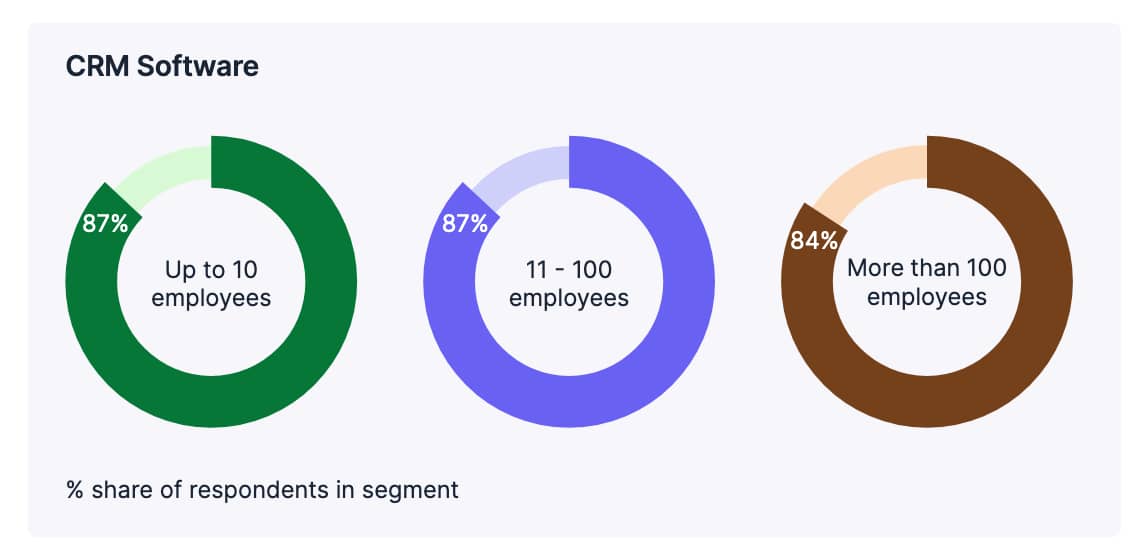
For example, Pipedrive’s CRM can automate lead scoring to help you prioritize promising deals. It also allocates leads to the most suitable sales reps and generates performance reports to track your sales pipeline.
Recommended reading

Sales performance measurement: 4 tips for tracking your team’s success
6 ways of generating leads for a small business
Relying on one lead-generation channel across your sales funnel leaves your business vulnerable to market changes. It’s especially risky for small businesses working to tight margins, as every lost sales opportunity can impact revenue.
For example, let’s say you mainly use online advertising to gain new customers. If ad costs rocket or your target market becomes saturated, your lead flow will slow. With leads no longer entering your pipeline, sales reps’ work will gradually dry up until you figure out your next move.
Combining those online ads with cold calling, sales referrals and search engine optimization (SEO) lets you maintain a steady stream of leads, even when one method fails. You’ll also reach a broader audience.
Diversifying your techniques is even more effective if they complement one another.
For instance, online ads work well with SEO as ads provide immediate visibility while SEO builds long-term organic traffic. Similarly, you can use cold outreach to introduce your business to prospects and webinars to build on that interest.
With that in mind, here are six cost-effective and complementary ways to find new customers for your small business.
1. Cold outreach
Cold outreach in sales involves contacting target audience members who have shown no interest in your product or service.
Typically done via email or phone, cold outreach requires patience and practice. However, it can generate high-quality leads if you pitch to people who fit your ideal customer profile (ICP).
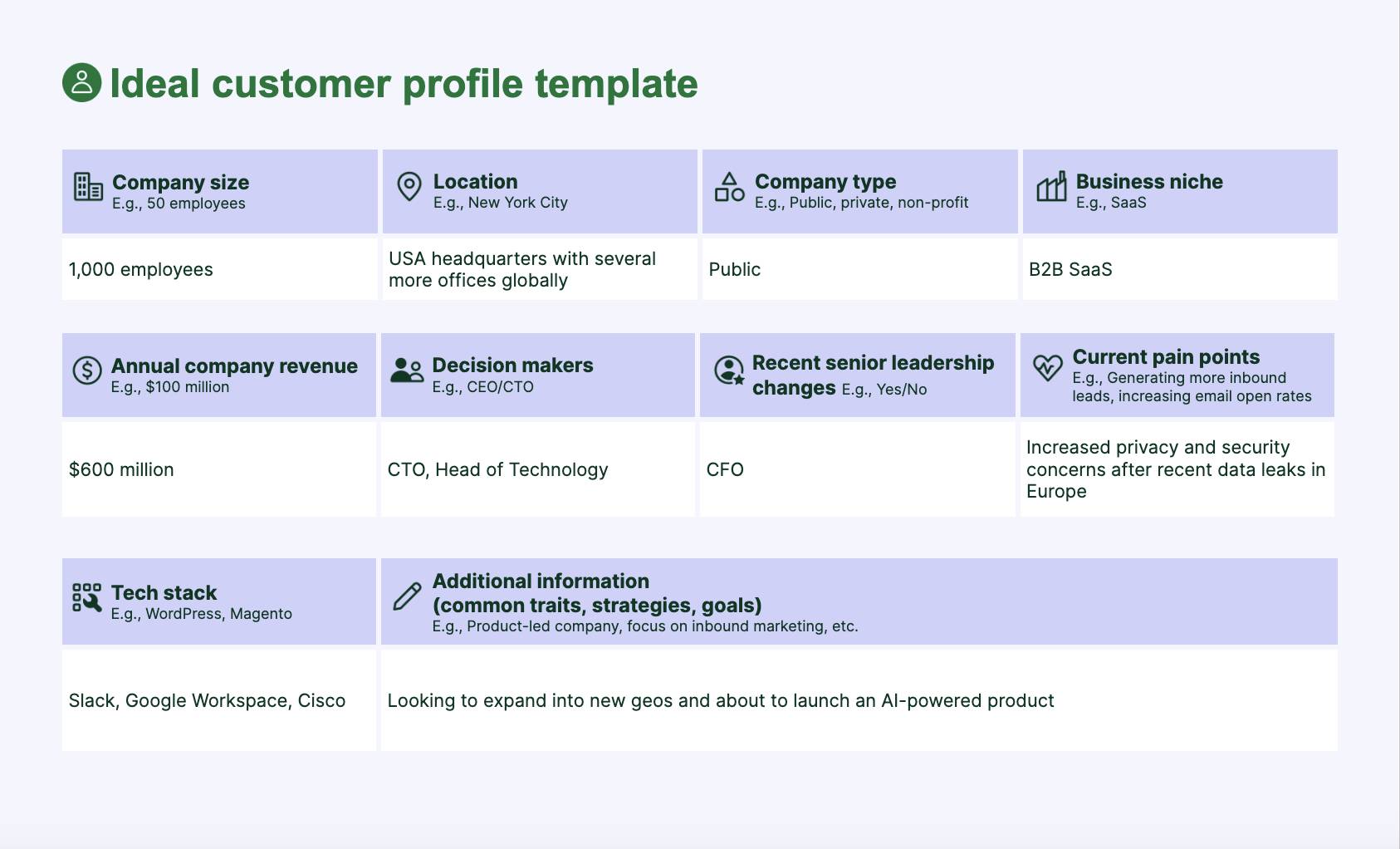
It’s particularly helpful for reaching business-to-business (B2B) decision-makers at the top and middle stages of the sales funnel (TOFU and MOFU).
Here’s where buyers first realize they have a problem and are considering solutions, so your direct contact can open the door for more meaningful conversations.
For example, a small software firm might contact IT managers at mid-sized companies. By pointing out that outdated technology slows productivity (a typical pain point) and offering a more modern solution, business reps can start conversations that may lead to sales.
Cold emails should always be personalized, concise and value-driven. Focus on how you can solve specific problems for recipients and make your points fast to keep the reader interested.
In the cold email template below, the sender addresses the prospect by name and explains the reason for reaching out almost immediately. It saves wasting the reader’s time.
Hi [prospect name],
People like you are super busy, so I’ll keep this short.
I work with companies like [business name] to help them [insert the main benefit e.g., get more sign-ups]. What our clients like most about us is this: [main selling point e.g., all leads on our platform have been qualified during the last six months, so the response rates are 2-3x the industry average.]
I’d love to give you or a colleague a 20-minute demo. Would next Tuesday or Wednesday work for you?
Warm regards,
[Name]
Cold calling requires a well-prepared script that addresses the prospect’s needs quickly. Listen carefully during the call and adapt your sales pitch based on their responses.
In the cold calling script below, the caller leads with their reason for reaching out: solving a specific problem for the prospect. They also reiterate their name so the buyer knows who to contact.
Hello, [prospect name]. This is Bob Bentz with ATS Mobile.
The reason for my call is I have an idea on how to possibly help you improve the troublesome process of recruiting employees, especially nurses. I wanted to see if it would make sense for us to have a quick conversation to find out more about it.
I can be reached at [your phone number].
Again, my name is Bob Bentz with ATS Mobile at [your phone number].
Thanks, [name].
Cold outreach requires no upfront investment, making it suitable for all budgets. It also works exceptionally well alongside the following lead-gen tactics:
| Referral networks | Get recommendations from peers and customers on who to reach out to and what problems they face. |
| Social selling | Browse social media feeds and groups to find potential customers and initiate conversations. |
| Webinars | Use cold outreach to invite people to virtual events where they can learn more about your brand and product. |
Note: Pipedrive’s AI email writer is an alternative to pre-made cold email templates and cold calling scripts that can speed up your outreach process. The tool generates professional messages in seconds based on a few simple instructions.
2. Long-term SEO strategy
By optimizing your website for search engines (SEO), you increase your company’s visibility to people browsing for products or services like yours at the TOFU stage. That’s valuable given that 93% of shopping journeys begin online.
For example, anyone searching “simple sales CRM” on Google will see Pipedrive among the top results. They’re more likely to click on that link than others further down the page.
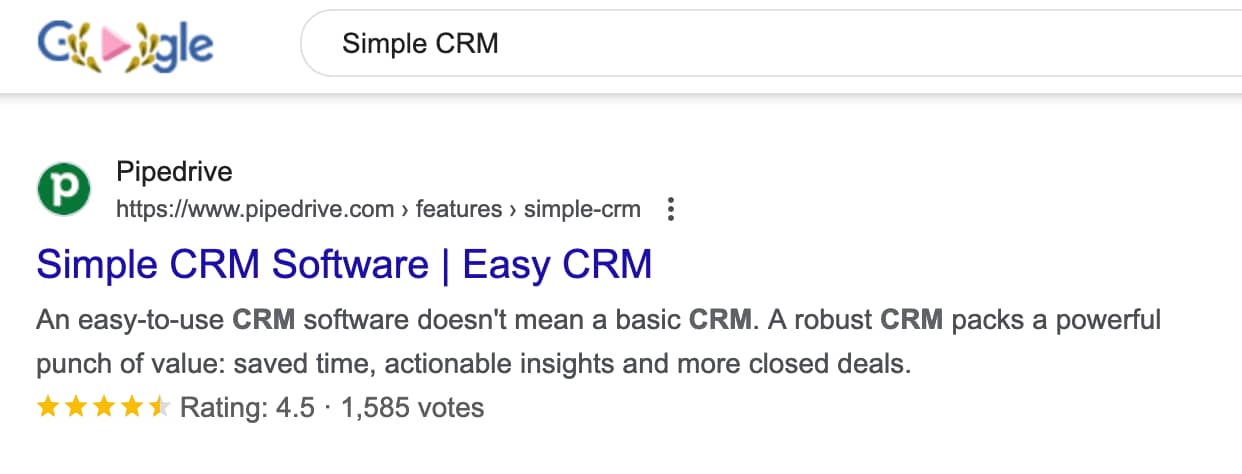
SEO can be complex and will benefit from expert support. With that said, there are still a few basics you can work on to improve your search rankings:
-
Keyword research. Identify the key terms and phrases your potential customers are searching for. Use tools like Google Keyword Planner or Semrush to find relevant keywords with high search volumes that you can target with your content.
-
On-page optimization. Optimize your website’s title tags, meta descriptions and headings for those relevant keywords and create high-quality content that addresses your target audience’s needs (e.g., a blog post on lead generation for small business reps).
-
Build backlinks. Reach out to industry blogs, participate in guest blogging and engage in online communities to earn valuable links to your site. These backlinks will guide traffic to your site and improve your search positions.
With so many free SEO tools and guides around, boosting search performance doesn’t need to cost much. SEO also complements the following lead-gen tactics really well:
| Online advertising | Balance the short-term impact of online advertising with the long-term benefits of gradually building your search visibility. |
| Webinars and podcasts | Use SEO techniques to drive traffic to registration forms and podcast landing pages. |
| Cold outreach | Ensure optimization so that when prospects research your business after your call or email, they find your website and marketing content easily. |
New to SEO? Consider an introductory course to build your knowledge. Choose a free one from a reputable provider like Semrush, Ahrefs or Yoast.
3. Online advertising
Search engine and social media advertising enables precise targeting to get your message in front of the people most likely to buy your product.
In addition to focusing on specific keywords, you can define your target audience based on location, job title, demographics and interests.
Here’s what that process looks like on LinkedIn:
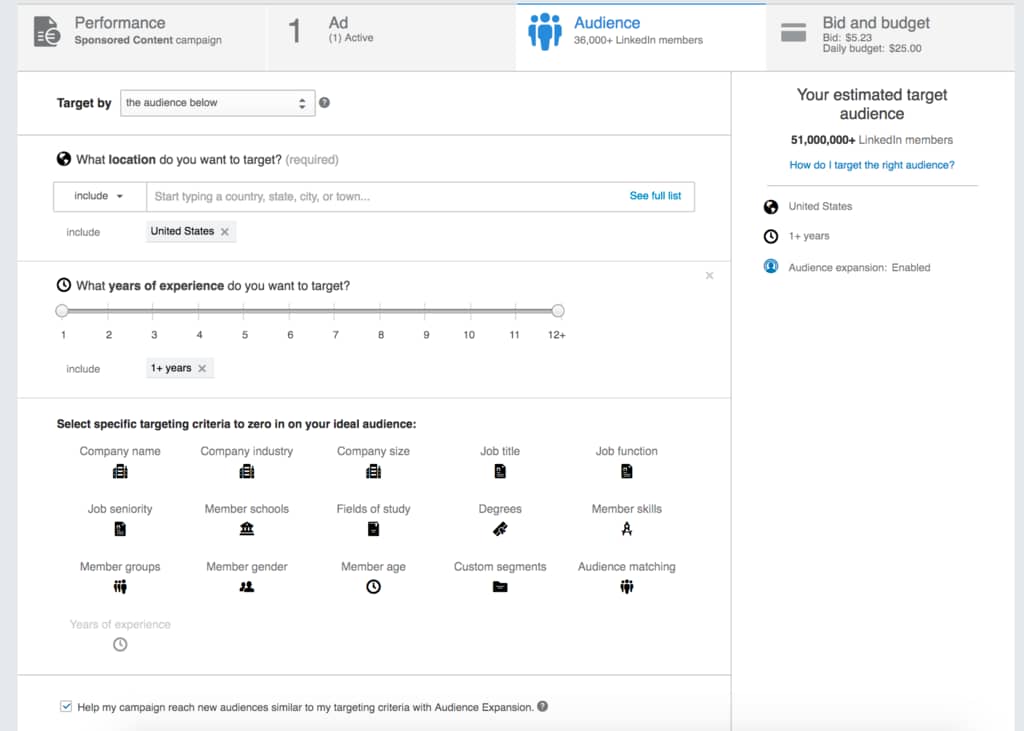
For example, a hosting company that serves the UK marketing sector – like Nimbus Hosting below – could target London agency bosses and marketing managers.
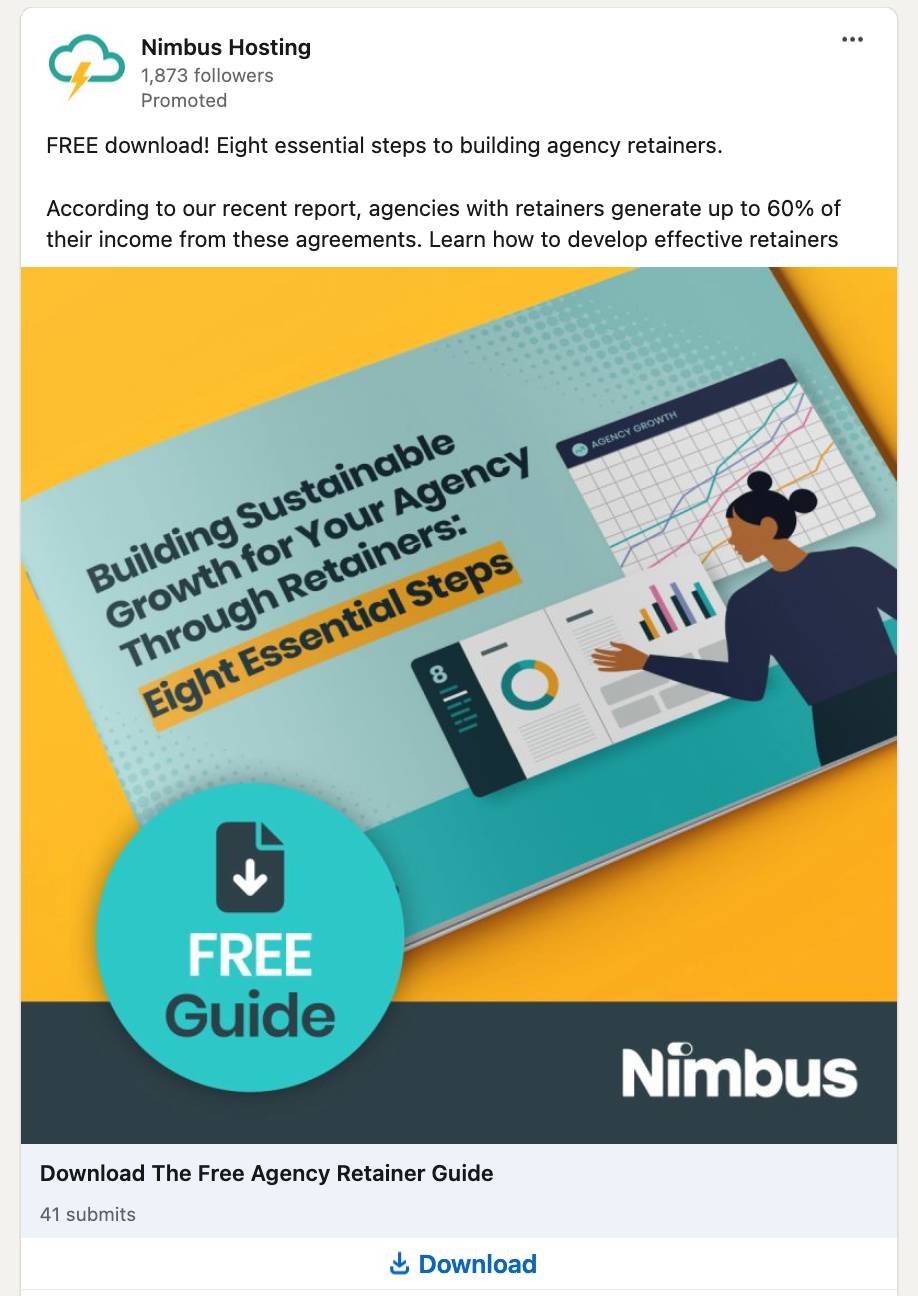
These users fit the company’s audience, so they’re more likely to click through during the discovery or research phase and become high-quality leads.
Online advertising is relatively simple but does involve some trial and error. Here are some simple tips for getting started:
-
Use A/B testing. Continuously test different ad variations to see which ones perform best. Test headlines, images and calls to action (CTAs) and combine the most effective elements.
-
Optimize landing pages. Ensure the landing pages your ads link to are ready to convert new visitors. Have a clear call to action, minimal distractions and relevant content that matches the ad’s message.
-
Monitor and adapt your budget. Regularly check your ad spending and performance to ensure you get the best ROI. If some ads or campaigns underperform, reallocate your budget to those that drive better results.
Targeting broad audiences and competitive keywords (e.g., “cheap hosting”) is expensive. Instead, focus your budget on niche markets and specific, long-tail keywords (“secure hosting for agencies”) where you’ll pay less and are more likely to see a higher ROI.
Online advertising works well alongside the following techniques:
| Search engine optimization | Complement the immediate impact of online advertising with SEO’s long-term visibility gains. |
| Webinars and podcasts | Promote events and new episodes using targeted ads on search engines and social media. |
| Social selling | Place targeted ads on the social platforms your ideal customers use most. |
Note: Pay-per-click (PPC) is an advertising model where advertisers only pay when someone clicks their ad, meaning there’s no upfront fee. It’s a smart move if you’re on a tight budget as it guarantees traffic for your investment.
4. Referral networks
Referral networks leverage word of mouth to generate leads by encouraging existing customers or connections to recommend your business. Sales referrals are effective as most buyers trust personal recommendations more than other forms of promotion in helping them make an informed purchase decision (at the BOFU stage).
For example, an e-commerce company could offer shoppers a discount in exchange for suggesting new customers, which incentivizes referrals while strengthening business relationships.
Start building a solid referral network by asking your most satisfied customers to recommend your services. You can make it easier by providing referral links or templates.
Some brands even publicize their referral programs in marketing content, like Monzo:
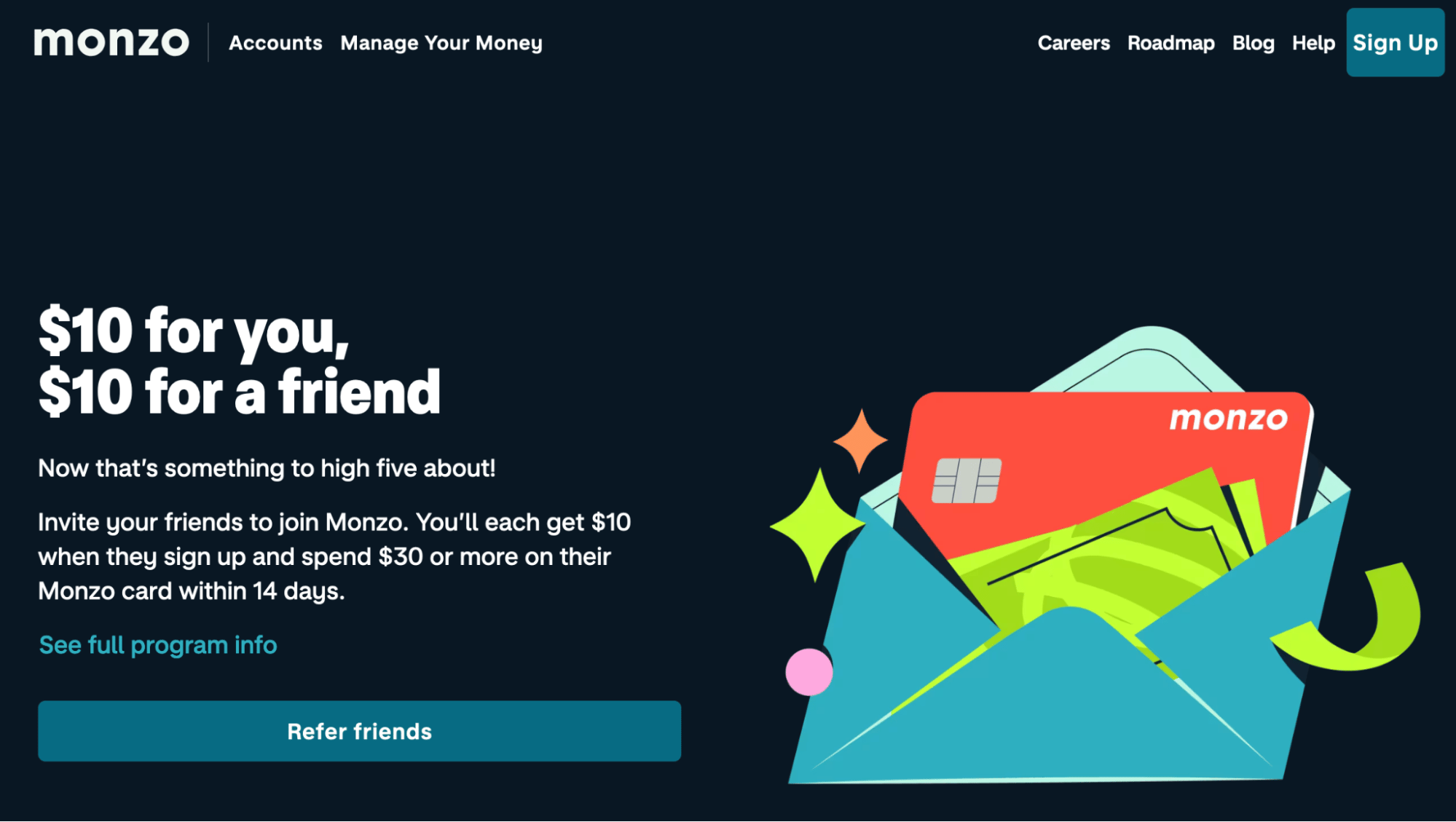
Consider partnering with businesses that can direct clients to you in exchange for mutual referrals. For example, a mortgage lender might partner with a real estate firm as they share similar target audiences.
Here are more tips for generating leads for small business owners through referrals:
-
Incentivize recommendations. Offer discounts and other rewards to customers who bring new business to you. Increase the incentives for those who generate lots of new leads – it’ll encourage them to keep recommending your brand.
-
Build strong relationships. Network in your industry by attending events, joining online forums and participating in community groups. The more you connect and show your value, the more likely others are to recommend your business.
-
Ask for referrals. Don’t be shy about asking satisfied customers for referrals. Sometimes, a simple request is all it takes to get them to suggest you to others.
Word of mouth is one of the cheapest ways to find new business, as it essentially means having customers do your marketing for you. It also complements the following lead-gen tactics perfectly:
| Search engine optimization | Ensure prospects who receive personal recommendations can find information about your business quickly. |
| Social selling | Encourage customers to recommend your business and share referral codes and links on social media. |
| Online advertising | Target existing customers with ads promoting your referral program. |
Tracking and rewarding referrals is crucial to keep momentum. Implement a CRM system to monitor who referred whom and ensure you deliver rewards promptly.
5. Social selling
Social selling means using social media platforms to find potential customers, build relationships and nurture leads.
Unlike direct advertising, social selling involves engaging with your audience through meaningful customer interactions and sharing valuable content. The aim is to establish yourself as a trusted expert.
This tactic is proven to be effective. According to LinkedIn’s Social Selling Index, 78% of social sellers outperform peers who don’t leverage social media.
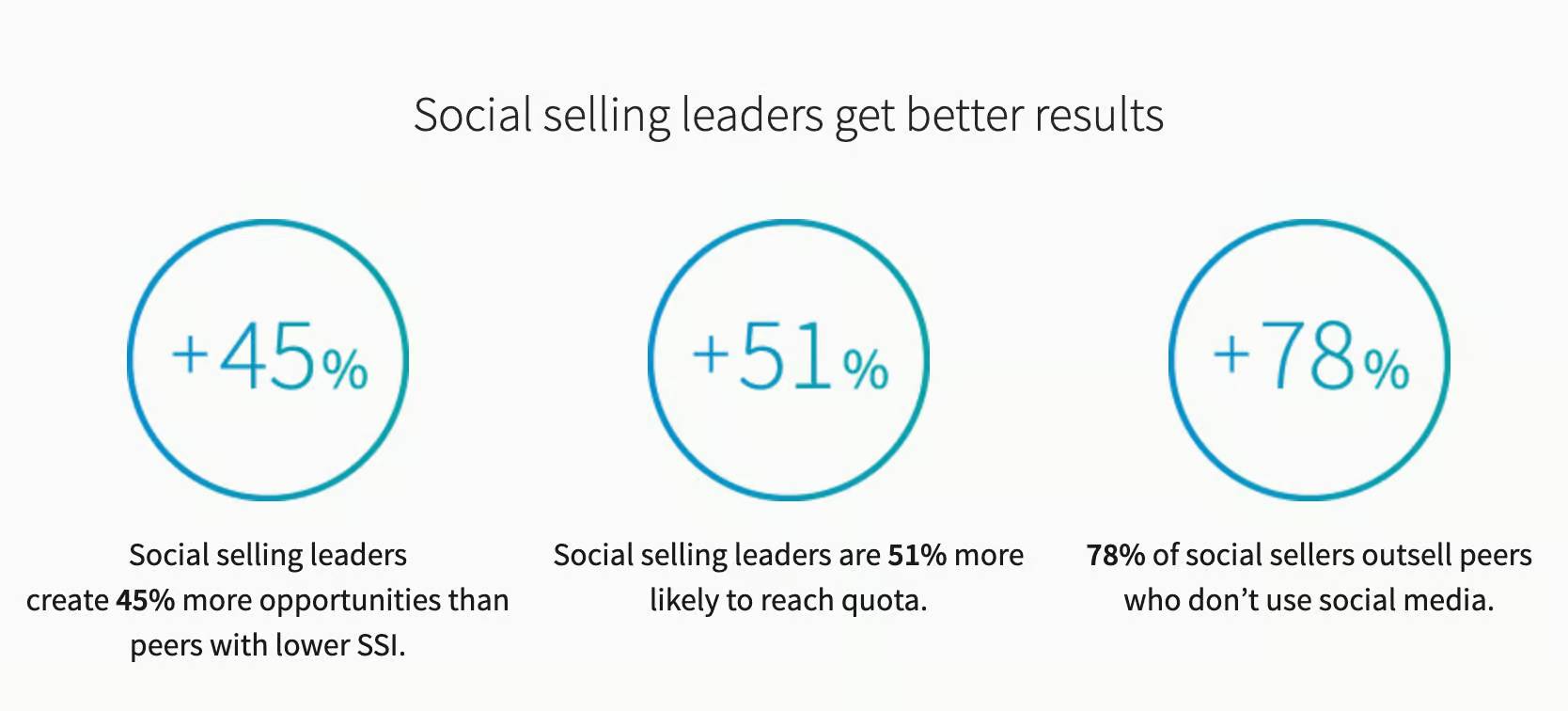
For example, a real estate agent might use LinkedIn to share market insights, comment on relevant posts and message potential clients. By consistently providing value, the agent stays top of mind with prospects.
To succeed with social selling, choose the platform where your target audience is most active and focus on building your network rather than pitching products. Social selling is about forging relationships, so patience is key.
Here are more tips for effective social selling:
-
Engage regularly. Interact with your audience by liking, commenting and sharing relevant content. Building relationships over time increases trust and makes it easier to approach potential leads.
-
Share valuable content. Position yourself as an expert in your industry by sharing informative articles, tips and insights. It’ll keep your audience engaged and attract sales prospects who value your expertise.
-
Use social listening tools. Hootsuite, Sprout Social and similar tools can help you monitor conversations about your brand or industry. Engage with users by discussing relevant topics and offering your insights to start forging relationships.
Social media sites are free to use. You can dedicate as much or as little time to selling on them and still get results. Social selling also works well alongside these other lead-gen tactics:
| Online advertising | Put your brand and products on social media users’ minds with targeted ads. |
| Search engine optimization | Drive extra traffic to your search-optimized content by sharing links on social media. |
| Referral networks | Encourage online communities to share referral codes and links or drive traffic to your referral scheme landing page. |
Remember that social selling and social media marketing aren’t the same, although both can help you achieve your sales goals. Where social selling focuses on relationship-building, social marketing (including advertising) is more about promoting specific products and building brand awareness.
6. Webinars and podcasts
Webinars and podcasts let you showcase your expertise, answer common questions and interactively address audience pain points.
Like social selling, webinars and podcasts help position you as an authority in your industry. That authority builds trust with prospects, making them more likely to consider your products as they are near the final stage of the sales funnel (BOFU).
There are two ways to build webinars and podcasts into your lead-generation strategy: as host or guest.
As a host, you can fully control and tailor the content to particular needs and interests. It allows you to create a platform where potential customers can regularly engage with your brand and deepen their connection.
Start by choosing a relevant topic that addresses a pressing need for your target audience. For example, Asana’s recent webinar helped viewers use AI more effectively at work.
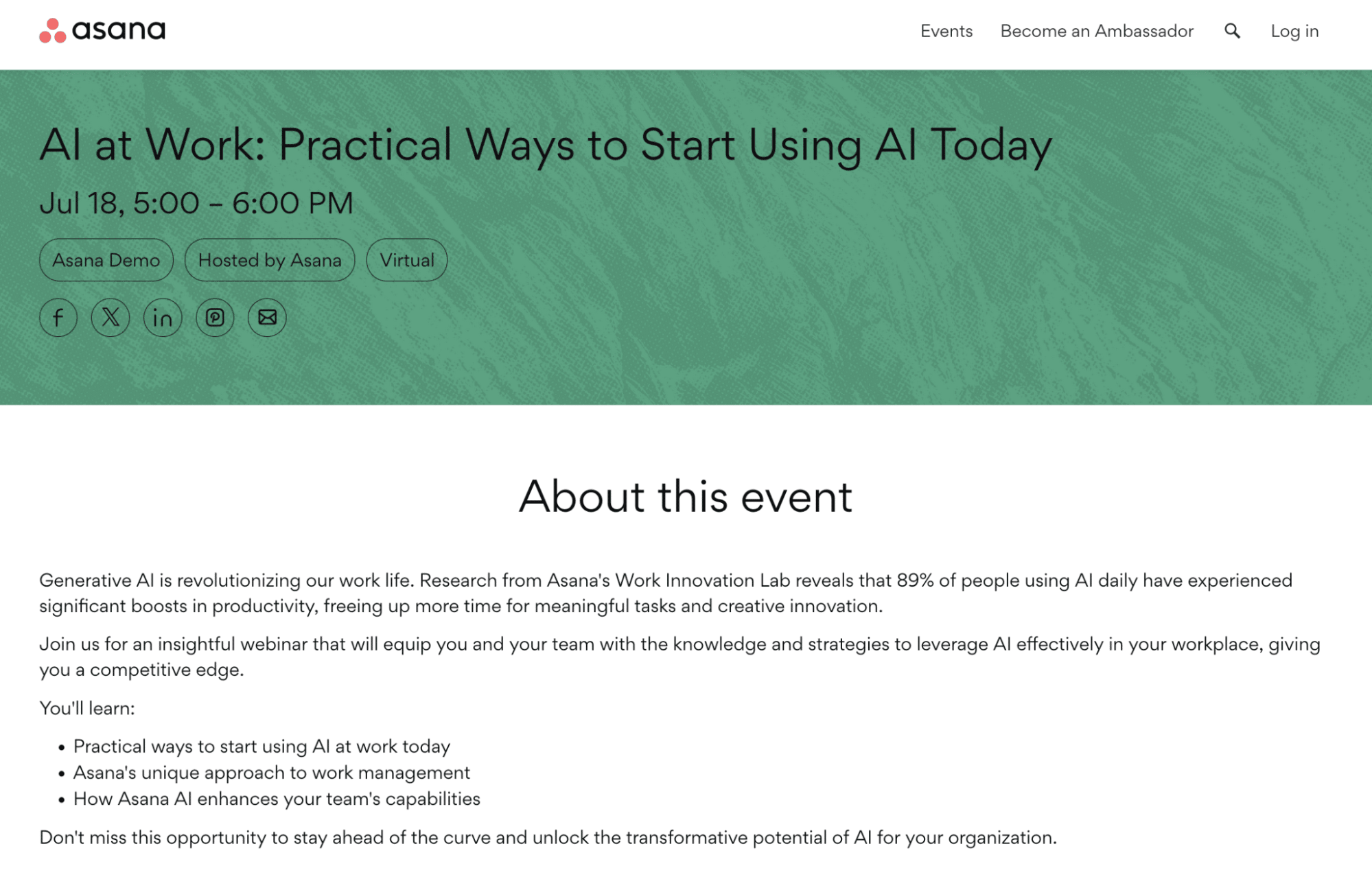
Then, choose a suitable platform (e.g., Zoom for webinars or Podbean for podcasts) and plan the first episode. You can promote it through social media, your website, online advertising and other content marketing formats.
As a webinar or podcast guest, you gain access to an established audience that may not be familiar with your brand. You can share your expertise and introduce your product to new potential leads.
Find valuable guest slots by identifying shows or events that align with your target audience. Look for platforms where your expertise would add value and the audience will be interested in your product.
Next, reach out to the hosts with a personalized pitch. Highlight your experience, suggest a relevant topic and explain how you’ll help their audience.
Although podcasting and hosting webinars require some upfront investment for equipment, they’re generally low-cost to run and promote. Use the following lead-gen tactics to encourage sign-ups and subscriptions:
| Search engine optimization | Optimize podcast and webinar landing pages for search and share invites and download links in relevant blog content. |
| Online ads | Advertise new events and episodes using targeted ads on search engines and social media. |
| Cold outreach | Invite new contacts to webinars where you can demonstrate your expertise and nurture them through the sales funnel to conversion. |
5 powerful lead-generation tools for small businesses
The right tools can make the lead-generation process much more efficient and cost-effective.
Use the following applications to find potential customers for your small business, organize lead data and measure the success of your marketing campaigns.
1. LeadBooster by Pipedrive
LeadBooster is an all-in-one lead-generation toolkit that you can add on to any Pipedrive plan.
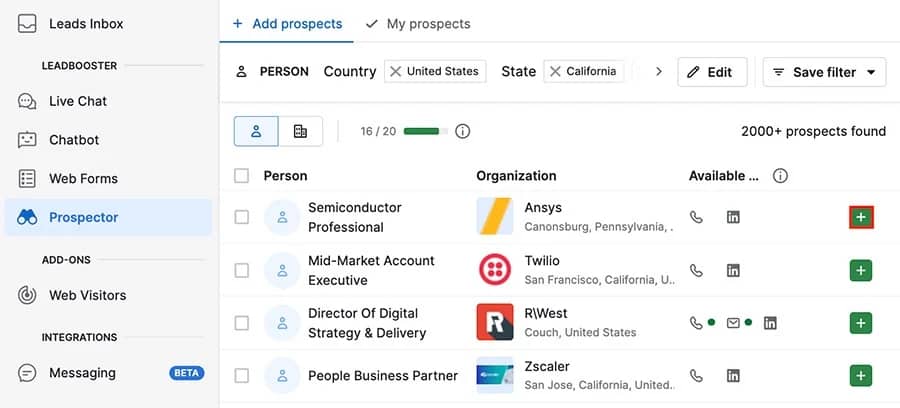
It has four useful tools for sourcing and nurturing leads:
-
Chatbot. Automate conversations with website visitors, guiding them through initial inquiries and capturing their contact information for follow-up contact. Available 24/7, chatbots ensure you never miss a lead even outside business hours.
-
Live Chat. Provide real-time support to potential customers who visit your website. Understand their challenges, ask direct questions and nurture them into your sales pipeline.
-
Prospector. Source high-quality leads from a database of over 400 million individual profiles and 10 million companies. Filter results by job title, location and industry to find buyers who fit your ICP.
-
Web Forms. Create and customize forms to capture inbound leads directly from your website. You can also share forms through social media and email marketing content to boost your reach.
Together, these features handle a lot of the hard work that small business owners typically put into generating leads. By automating some aspects and simplifying others, you’ll gain more time to run your company.
All of LeadBooster’s tools synchronize with Pipedrive, meaning the data you collect goes straight into your CRM so sales reps can follow up and build trust. That way, your lead data stays consistent and accessible without you or your busy team needing to manually input data.
For example, Leads Inbox – which is available to all Pipedrive users – stores your leads before they enter your sales pipeline. It means they don’t overcrowd the pipeline view and confuse your team.
Pipedrive can also automatically assign qualified leads to the most suitable reps. It frees your time to build more effective sales and marketing strategies for your small business.
Note: You can add LeadBooster to any Pipedrive CRM plan from $32.50 per month per company.
2. Google (Ads, Analytics and Search Console)
Google’s digital marketing tools are handy for reaching large online audiences and measuring your SEO efforts. They’re particularly valuable in small business settings as they’re free to use, meaning they won’t affect your sales or marketing budget.
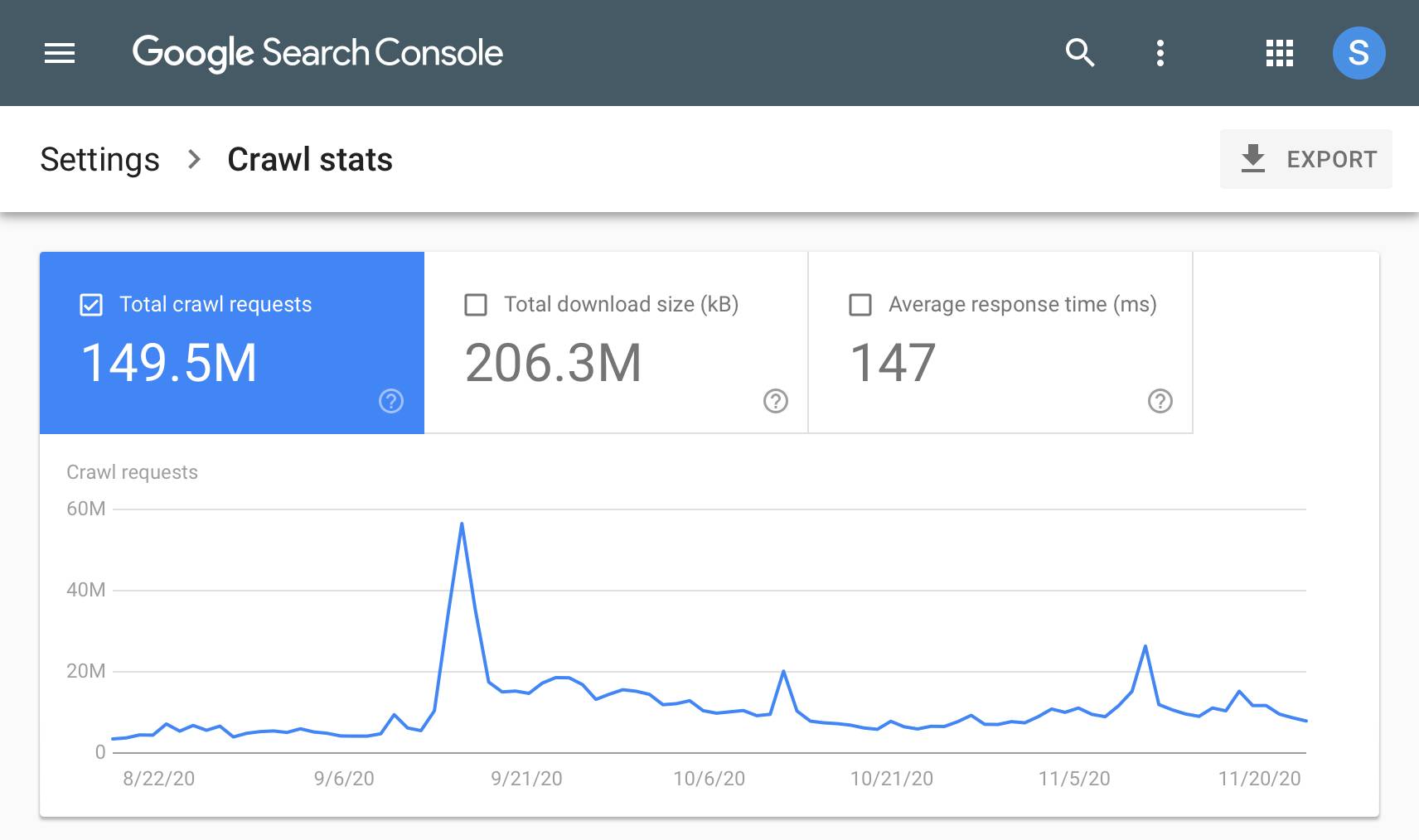
You’ll find that the expert agencies – the lead generation companies for small businesses, rely on Google data, even if they use other tools.
Here are the three main Google tools to build into your lead-gen strategy:
-
Google Ads allows you to create targeted online ads to reach potential customers via search results, YouTube and other Google platforms (the tool itself is free to use but ad costs vary).
-
Google Analytics 4 (GA4) shows how users interact with your website using metrics such as pageviews and conversions. The data helps you understand your audience’s behavior, optimize your marketing efforts accordingly and measure lead generation.
-
Google Search Console helps you monitor and maintain your site’s presence in Google search results. It offers valuable data on your rankings and suggests ways to grow your online visibility and get more leads.
Getting to grips with all three tools can take time, so be patient as you learn their features. They’re all free and Google offers plenty of training materials via Skillshop.
3. LinkedIn
LinkedIn allows businesses to connect with professionals, build relationships and promote their products or services to targeted audiences.
The platform enables professional networking, making it one of the best places to find B2B leads. You can find and nurture those leads in various ways:
-
Contributing to industry-relevant posts
-
Targeting buyers with engaging ad content
-
Building and joining communities to share your expertise
-
Posting topical content to drive traffic back to your website
In addition to the main social networking interface, LinkedIn offers additional tools to help you generate leads. These tools include LinkedIn Ads, sponsored content and InMail.
Here’s the interface for setting up sponsored messages, where you can pay to target LinkedIn users with cold outreach:
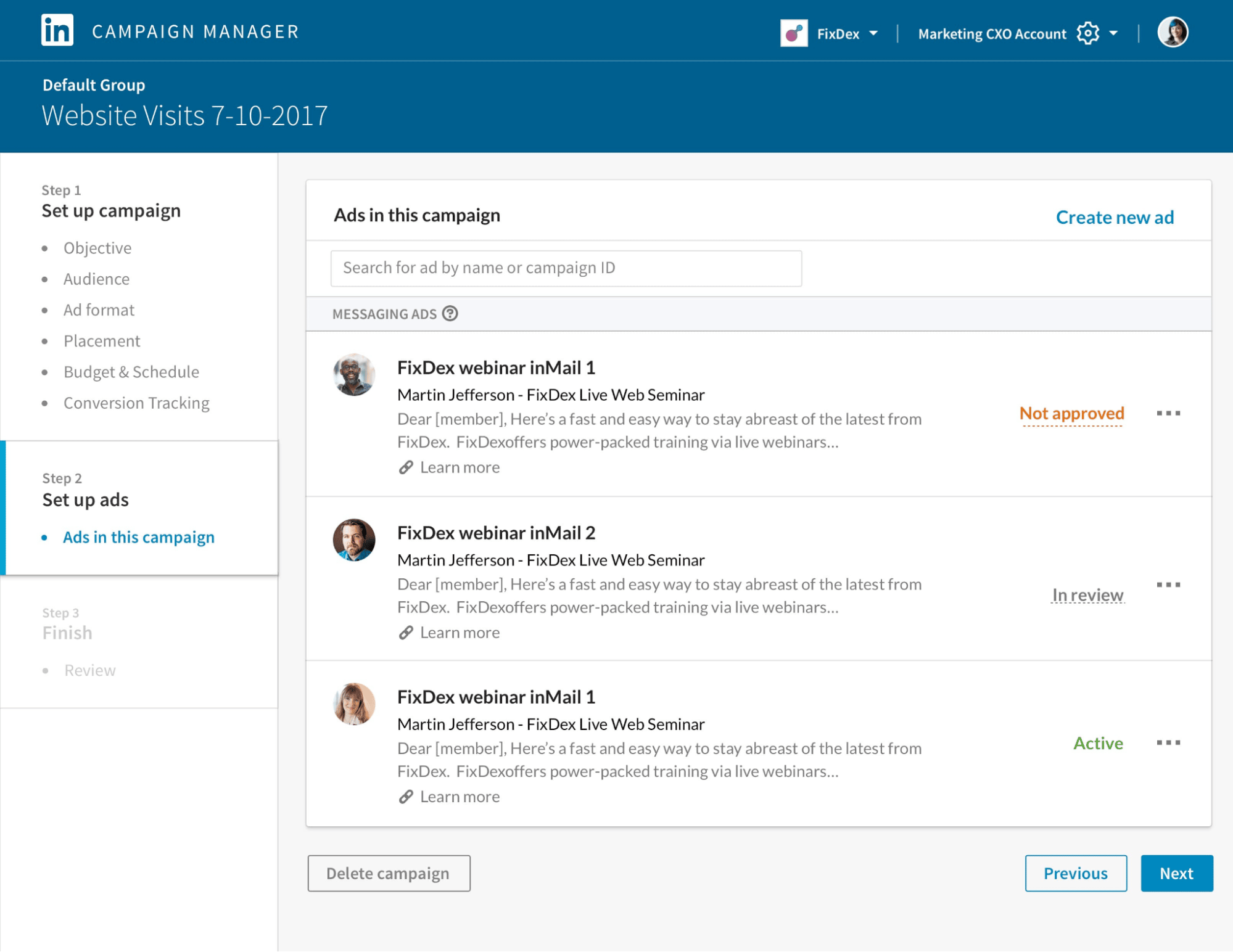
The LinkPort integration lets you import unlimited LinkedIn contacts to Pipedrive in a single click. It also keeps your CRM records up to date by automatically syncing new information.
4. Referral Factory
Referral Factory is a simple tool for creating and managing referral programs. It speeds up the process of generating valuable leads through word of mouth – handy for small businesses with limited time and resources.
As well as offering customizable templates for creating new campaigns, the lead-generation software allows you to track referrals and reward customers for successful introductions.
You can also use Referral Factory to generate affiliate links. These are unique URLs that customers, influencers and other marketers can share to drive traffic to your site in exchange for commission or discounts.
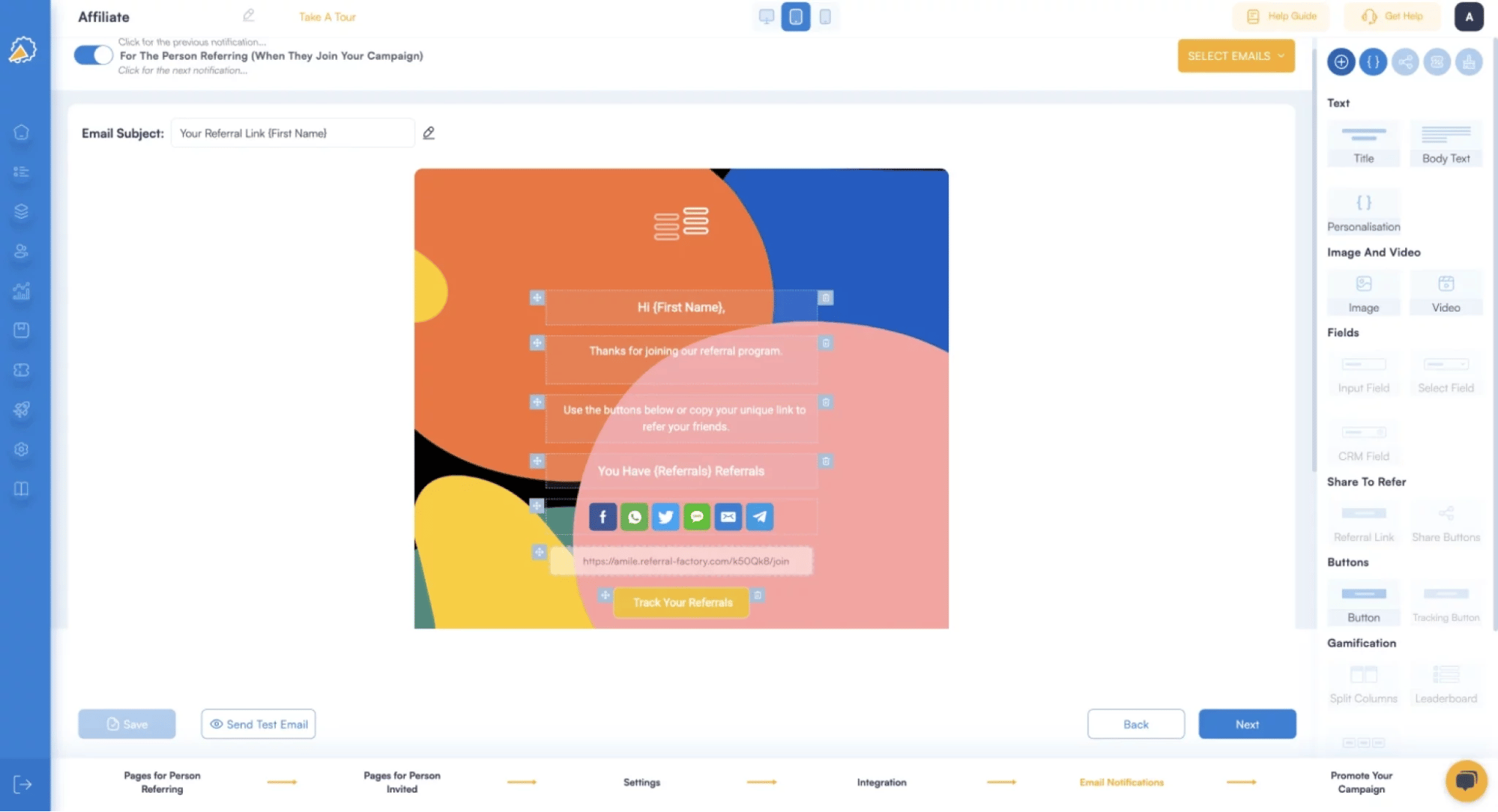
Other helpful features include referral tracking for users (providing extra transparency and motivation), multi-language support and automated reminder emails.
Referral Factory integrates with Pipedrive, too. Connecting both apps allows you to sync contacts, generate unique referral links and import new lead data to your CRM.
5. Trustmary
Trustmary is software for collecting, organizing and showcasing customer testimonials and reviews. These powerful forms of social proof can significantly boost the credibility of a new or growing small business and ultimately attract valuable new leads.
Use Trustmary to import reviews from various sites. It can generate widgets and embed them on your site to build trust with potential customers.
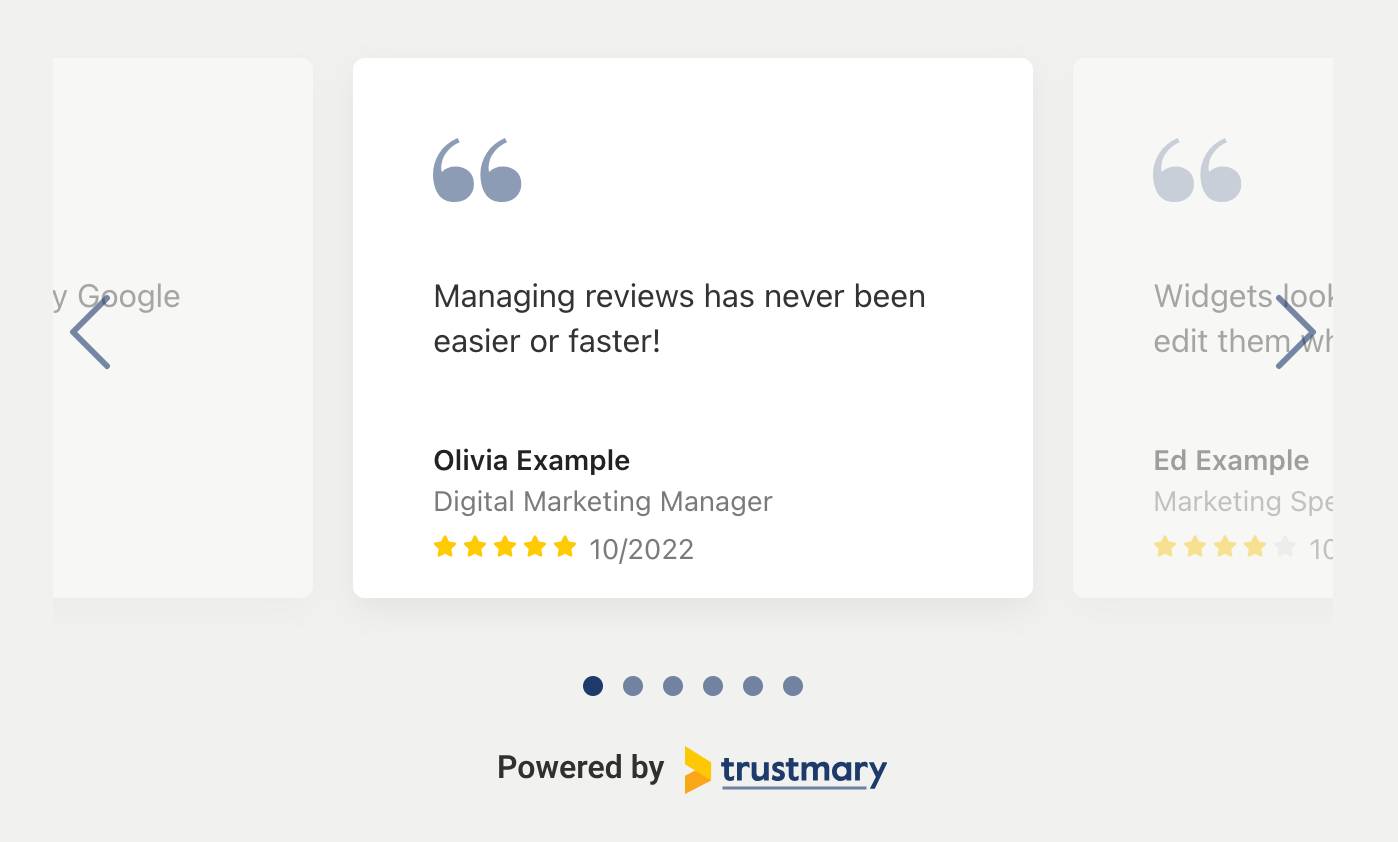
The app can synchronize reviews from Google, G2, Yelp and many more platforms.
Trustmary offers seamless CRM integration, too. Connecting it to Pipedrive, for example, allows you to trigger customer feedback surveys at certain pipeline stages. You can also collect customer satisfaction (CSAT) and net promoter score (NPS) data to gauge customer sentiment that can help your sales process.
Note: Social proof isn’t limited to reviews and testimonials. A CMI survey found that 53% of B2B marketers consider customer stories and case studies as very effective.
Final thoughts
Lead generation is critical for all growing small businesses, so you may face a lot of competition when searching for new customers.
To stand out and connect with buyers, target your audience accurately and effectively across different channels at all stages of the sales funnel. With this approach, you’re more likely to reach the right people at the right moments and convert them. If you’re still not sure, there are plenty of focused lead generation companies for small businesses you can outsource this to.
Using the tactics and tools in this guide, you can build a strong lead-generation strategy that attracts high-quality prospects and keeps your sales pipeline full.
Catch more hot leads before they bounce
Want piping hot leads delivered 24/7? You need this Guide to Automating Lead Generation.
If Pipedrive is of interest and you'd like more information, please do make contact or take a look in more detail here.
Credit: Original article published here.
